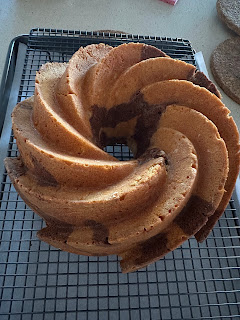When I was reading up on this, there are two kinds of orange chocolate cakes. There is the Jeffa cake, which combines the chocolate and orange. The one I want has to split up orange and chocolate components, because I want to taste them differently. So I chose the marble cake from Pies and Tacos. But I do want a granache glaze so I used Smitten Kitchen's recipe which was to suit a 10C bundt cake.
Ingredients (recipe is for 12C but I've downgraded to 10C for my bundt)
398g flour
27g cocoa powder
15g baking powder
¼ tsp salt
236g butter, softened
416g sugar
4 eggs
1¼ tbsp orange zest
1.46 C orange juice
Glaze
1 tbsp butter
1 tsp orange zest
2 tbsp orange juice
¾ sugar OR
Granache (from Smitten Kitchen)
225g semisweet choc chips or chopped choc
120ml (½C) heavy cream
Method
1. Grease bundt.
2. Divide flour into 2 bowls (approx 199g per bowl). Add half of baking powder (7.5g). Add half of the salt (ie about ⅛ tsp).
3. Add cocoa powder to just one bowl.
4. Sift both bowls (separately of course).
5. Cream butter in stand mixer for 2 minutes. Add sugar gradually and keep creaming for 2 - 3 mins until pale and fluffy.
6. Add eggs one at a time and ensure each is fully incorporated before adding the next. Scrape down after each addition.
7. Add orange zest and mix to combine.
8. Weigh cake batter and divide into 2 bowls. Divide orange juice. 0.8C (slightly more than ¾C) for orange batter. Remainder for chocolate batter.
9. Work in each bowl separately. Sift dry ingredients in each bowl.
a. To orange batter, add 0.8C orange juice. Sift in the dry ingredients and whisk to fold in. To avoid curdling, start with flour, then juice. Alternate flour and juice and fold after each addition. Start and end with flour.
b. To the chocolate batter, add remainder of orange juice. Sift in the dry ingredients. Similar to above, start and end with flour by alternating dry, wet, dry until all the ingredients have been used up.
10. To assemble, pour ⅓ of orange batter at the bottom. Top with ½ of choc batter. Top with ⅓ of orange batter. Pour on remaining half of the choc batter. Finish with remaining orange batter.
11. Bake at 175 deg C for 60 minutes (recipe said 40 to 50 minutes, that was so wrong!) Tent if top becomes too brown. Cake is ready when toothpick inserted comes out clean. Cake should spring back when you touch the top with your finger.
12. Remove from oven and allow to cool in pan for 10 minutes over a rack.
13. Make the glaze or granache. If using granache, cake has to be completely cool before pouring on the granache.
14. To make the glaze: put in a small saucepan and combine until sugar is melted.
15. To make the granache, add hot (not boiling) cream to the choc. Allow to stand for 3 minutes before stirring with a metal spoon only!
16. Unmold the cake after 10 minutes in the pan (not too much longer or the cake will stick to the pan) and flip onto the cake rack. If using glaze, brush on the glaze. If using the granache, allow cake to totally cool before pouring on. Only cut the cake when the cake is cool.










